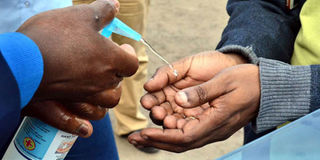Making harmful concoction in the name of sanitiser?

A Nairobi resident sanitises his hands. A good hand sanitizer should be at least 60 per cent alcohol for it to be effective, according to CDC. PHOTO | FRANCIS NDERITU | NATION MEDIA GROUP
As Covid-19 ravages the world, the use of hand sanitisers as one of the ways to prevent disease spread, has become the new normal.
So high has been the demand for hand sanitisers that they have since become hard to find in chemists, shops and supermarkets countrywide. The government has had to intervene to bring their cost down.
As a result, Kenyans have resorted to homemade sanitisers, with DIY messages now all over social media. The danger of this has been should you not use the right ingredients to make the sanitiser, you either end up with an ineffective product or one that is too harsh.
Although the Centres for Disease Control and Prevention (CDC) recommends hand washing with soap and water, it does advocate sanitiser where these are not available. According to CDC, an alcohol-based hand sanitizer is the safest and most effective. Both the World Health Organization and CDC recommend a sanitiser with at least 60 per cent of alcohol as an effective way of dealing with the virus.
Mercy Akinyi, a biochemist at Institute of Primate Research, advises at least 70 per cent alcohol and pure glycerine to make an effective sanitiser. The glycerine, says Mercy, is important because alcohol is highly volatile, and adding glycerine reduces the rate at which it evaporates, giving it time to do its work against germs.
"If you use a sanitiser that has less alcohol, it will be ineffective. The drug index, which measures if a drug can work, requires a certain concentration so as to kill pathogens," says Ms Akinyi.
Pharmaceutical Society of Kenya president, Dr Louis Machogu, discourages people from home-made sanitisers because of some of the dangers they expose themselves to.
He advises people to get hand sanitisers approved by the Kenya Bureau of Standards (Kebs). Kebs has advised manufacturers to adhere to marking and labelling requirements and have to detail the composition of the sanitisers. Failure by some entities to do this has led to the cancellation of some of the sanitisers that were in the market.
"Everyone wants to be a sanitiser trader, forgetting that there's an element of effectiveness that is required. If there's no alcohol content of more than 70 per cent, using the product will not be different from washing your hands without soap," says Dr Machoge.
Since alcohol burns easily, you could be at risk of getting burns if you are not careful, he warns. The sensitivity of the chemicals used in making hand sanitisers may also damage your
skin, he adds.
"This is not a season to make a business killing from sanitisers, since we have to make products that are effective, safe and do what they are meant to do," says Dr Machogu.
Methylated spirit, which some people have also been using, is also not advisable. Dr Machogu says it could cause methanol poisoning.
The most common form of methanol poisoning drinking illicitly produced fermented alcohol such as chang'aa. But, CDC warns that the absorption of methanol through the skin is as effective as the oral route in producing toxic effects. WHO outlines some of the effects of methanol poisoning, which include drowsiness, headaches, abdominal pain and vertigo.
Adverse cases could lead to breathlessness, blindness or even death.
Dr Machogu, therefore, insists on professionalism when it comes to compounding hand sanitisers. A pharmacist, he says, is the ideal professional to come up with one.
"If you ask a pharmacist to compound a hand sanitiser for you, they can do it, both for home use and for resell if you plan to sell. But, it has to be approved by the Kenya Bureau of Standards for you to sell it," he says.
Even so, hand sanitisers generally need to be prepared with care because of the nature of the chemicals used to make them. WHO warns of some of the risks people are exposed to when preparing hand sanitisers.
Generally, the contents are highly flammable, making it dangerous to have it near fire. As a user, you are discouraged from using a hand sanitiser near a fire place. Intentional ingestion of sanitisers is also harmful to your health.
WHO also recommends that sanitisers should not exceed proportions of more that 50 litres locally or in central pharmacies which do not have a specialised air conditioning and ventilation.


